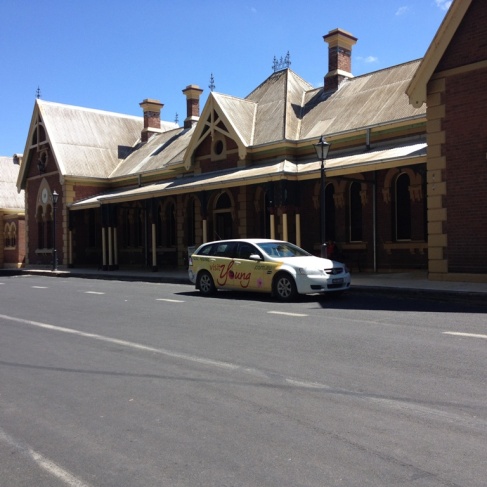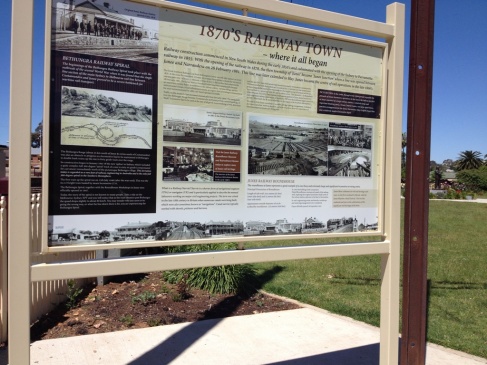Day 2 – Off to Bethungra Dam.
Today was going to be a little more straight-forward as we decided to camp at Bethungra Dam. We travelled through Young and Cootamundra to get there.
When we left Gooloogong we travelled through Grenfell. I love the intro to their information site
What do notorious bushrangers, guinea pigs, great Australian poets and cricketers all have in common? Grenfell of course!
Every year they have a Henry Lawson Festival to celebrate the fact he was born in Grenfell. It is quite an historic town, originally a gold mining town it was known as Emu Creek and renamed Grenfell in 1866.
Young was our next stop so we parked the vans and visited the Information Centre to find out what we should see. The information centre is in the old Railway Station and the staff are really helpful.
As Jack was ready for a run we decided to go out to the Chinese Tribute Gardens which were established to recognise the contribution of the Chinese gold miners during the gold rush – and probably to make amends for the terrible treatment they got at the Lambing Flat Riots. It was a beautiful and peaceful place – free to enter – and a lovely stopover for a picnic lunch.
Here’s Jack (and Marion) ready to enjoy a walk around the gardens.
In November 1996 Rotary handed the project over to Young Shire Council. Encouraged by Mayor Tony Hewson the Council formally dedicated the Lambing Flat Chinese Tribute Garden “in recognition of the contribution of the Chinese community to the settlement of Young in the 1860’s and the ongoing contribution of the Chinese community to Australia as a nation.”
You can read more about the development of the gardens here.
Young was originally called Lambing Flat and Aussies may remember learning about the Lambing Flat Riots when you were at school. This is a brief synopsis from the Young website, but you can find out more if you click here.
The site where Young now stands consisted of a well sheltered valley with good water and it was here that White built sheep yards and a shepherds’ hut. The area was reserved for lambing ewes, and therefore was in turn given the name of ‘Lambing Flat’.
The beautiful valley remained as such for 34 years until 1860 when White’s nephew Dennis Regan and Alexander ‘the Yankee’ found gold at the spot in the creek at the rear of the current Lambing Flat Folk Museum. Within 12 months some 20,000 miners were busy extracting the precious metal from the earth. Amongst them were some 2,000 Chinese miners.
The European miners deeply resented the Chinese and in 1861 riots began with the Chinese being forced from the fields time and time again. The Official Riot Act was read to the miners on the 14th July 1861, this being the only official reading in NSW history to rioting miners.
Today, Young is more famous for its cherries and they have a festival coming up in December that you can get more info about here. One of the locals told us that frosts and a dry winter have restricted the cherry crop this year, so if you thought they were expensive to buy before just wait until they hit the shops this year!
 We didn’t stop in Cootamundra but drove through on our way to Bethungra Dam. I was looking forward to seeing the Cootamundra Wattle, which I thought would be flowering at this time of the year but it wasn’t noticeable. When I started looking for info about this wattle it is described as a weed!
We didn’t stop in Cootamundra but drove through on our way to Bethungra Dam. I was looking forward to seeing the Cootamundra Wattle, which I thought would be flowering at this time of the year but it wasn’t noticeable. When I started looking for info about this wattle it is described as a weed!
For more info about Cootamundra click here.
The camping area at Bethungra Dam was a good open space, lots of level ground – and not too many people. There were plenty of sticks so Jack was happy. We watched a storm rolling in as we ate dinner which didn’t arrive as bad as it looked, but before it came there were thick clouds of mosquitoes hovering, so it wasn’t the best night for sitting around for a drink and a yarn.
The campsite is about 5 kms of dirt road in off the main road and you travel beside the railway line for a while.
When we got to Junee the next day they had some really interesting information about the 360degree spiral rail at Bethungra, the only one of its kind in Australia. All you rail enthusiasts can read about it here.
Junee also has an amazing rail feature and they celebrate with a Rhythm ‘n’ Rail Festival each year. Here’s the link for the event in 2014.
The Junee Roundhouse is a massive rail turntable that was built during the war years.
Junee in southern New South Wales is home to one of few working Railway Roundhouses in the Southern Hemisphere. When built in 1942, it boasted the largest turntable at 100 foot. Since 1994, the Roundhouse has seen a new lease of life. Half is now used for the museum, whilst the other portion is used for its original purpose of re-conditioning and rebuilding locomotives and rolling stock.
This is definitely an area that any train buff would love, what with the Bethungra Spiral and Junee’s Roundhouse you could see 2 amazing features so close together. There’s more information about the Roundhouse here, if you are interested, and also at this site of the Roundhouse Museum.









